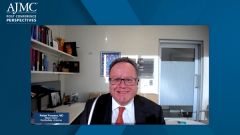
Rescue Isatuximab in Transplant-Ineligible, Treatment Naïve NDMM
Rafael Fonseca, MD, reviews data on rescue isatuximab from the ASH 2021 annual meeting and discusses use of best therapies up front.
Episodes in this series

Transcript:
Rafael Fonseca, MD: A study was presented in which isatuximab [Sarclisa] was considered rescue therapy for patients who would be treated with lenalidomide [Revlimid] and dexamethasone in the setting of transplant-ineligible, newly diagnosed multiple myeloma. The notion was, does it make sense to hold on to isatuximab and then add it down the line in patients who are inadequate responders? This study was reported, and overall, the report is good. It shows that for some patients you can improve the quality of the response you’ll get by the subsequent addition of the monoclonal anti-CD38 antibody. This is a small study of 42 patients, so it needs to be expanded and tested further. It was notable that a number of these patients have early progression and depth. That’s obviously something that needs to be considered because the outcomes for patients who were treated with front line, particularly if we use a reference such as MAIA are pretty good. That benchmark is high.
I don’t favor these approaches for a couple of reasons. One is, we have shown through our studies that there’s attrition. Sometimes this includes patients who might say, “I’m tired of treatment. The treatment is too toxic. I don’t want to do that.” You lose the opportunity to propose them to persuade someone to get additional treatment. At the last ASH [American Society of Hematology Annual Meeting], a Canadian group developed a similar study that has some logic built into it, that this might be a way to save money on medications. What they were able to show is that if you add—in this case—pomalidomide [Pomalyst] down the line and only if needed, you could not catch up with the losses that you had already from those patients who appear to be to be progressing. The study is interesting. But given what I know about attrition and with this study, I don’t favor this approach, whether it’s with daratumumab or isatuximab—really, this is drug agnostic. In my mind, we must put the best treatments together from the get-go to achieve deeper and the most lasting responses in our patients.
An exception could be with isatuximab or other treatments. If we have a patient who seems to be frail and would not be able to tolerate one of the standard combinations, an argument can be made that 1 could start with a doublet—for instance, Rd [lenalidomide, dexamethasone]. But with the data we have, if that person regains strength and functionality, adding that medication might make sense. In fact, I would use a study—not to say that that’s the best way to go forward, but more that it’s the exception for patients who are frail. It’s a reminder that if the patient becomes stronger, it’s probably better to augment the intensity of the treatment that’s provided up front.
Transcript edited for clarity.
Newsletter
Stay ahead of policy, cost, and value—subscribe to AJMC for expert insights at the intersection of clinical care and health economics.































































